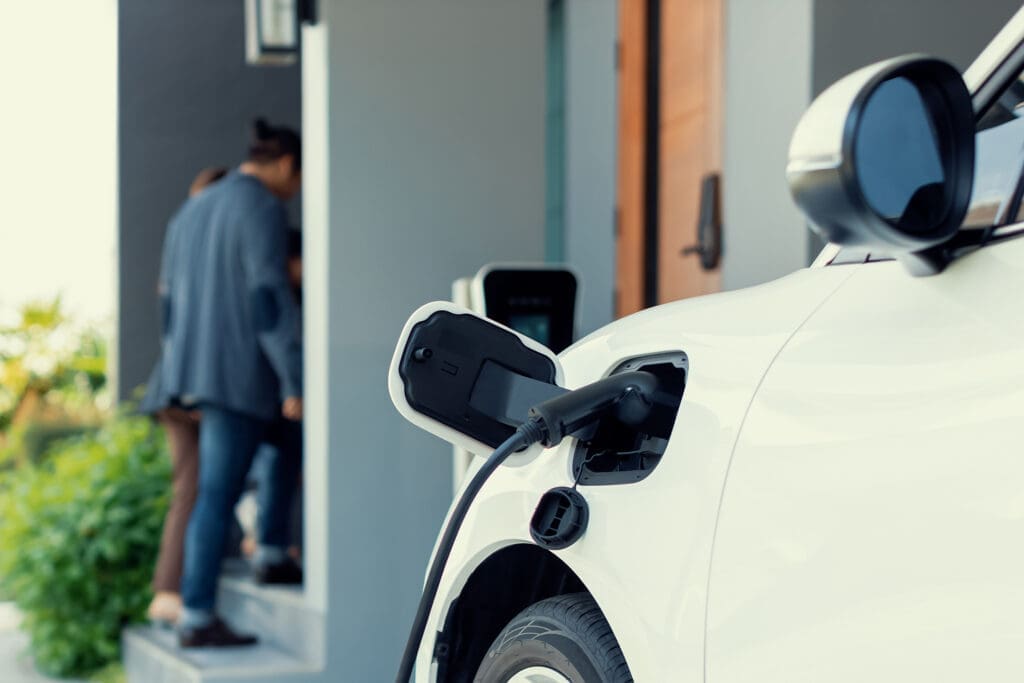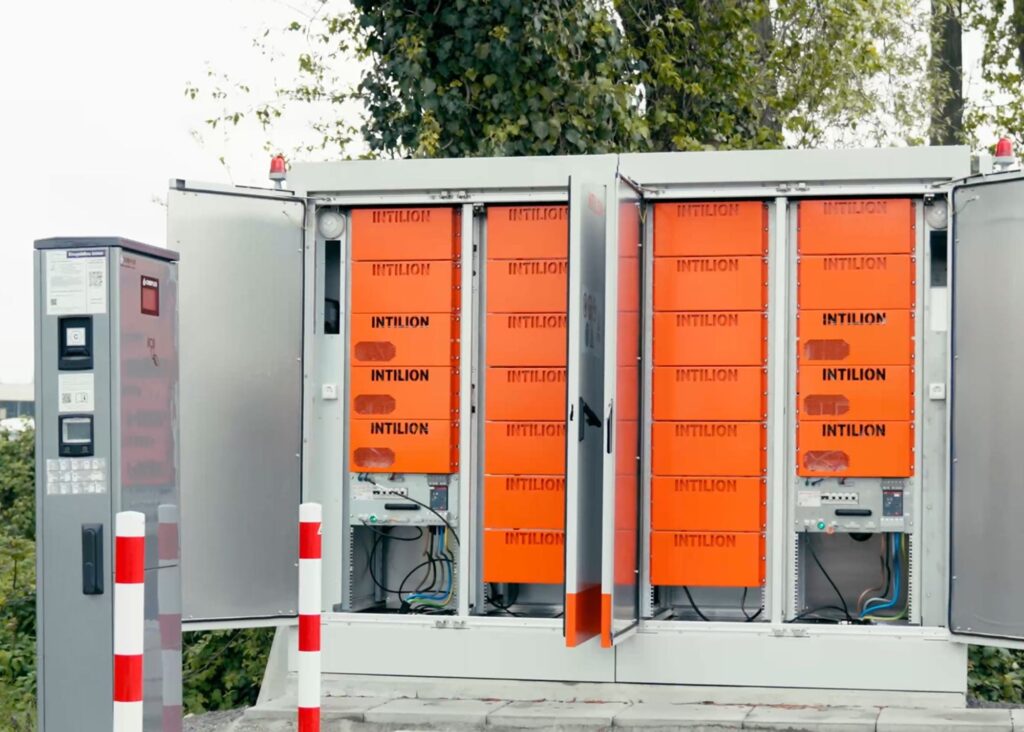The benefits of charging stations and energy storage for businesses
The combination of charging stations and energy storage offers significant advantages for businesses in the e-mobility sector. It enables the cost-efficient operation of electric vehicle fleets and supports fast charging, even during peak demand. This not only promotes electromobility but also enhances energy efficiency and strengthens a company’s sustainable image.
- 7 Min.
In a world where sustainability is becoming increasingly important, businesses are increasingly interested in shifting their energy sources to renewable alternatives. Installing charging infrastructure and energy storage offers an effective solution for companies to meet their energy needs while also protecting the environment.
Charging stations enable businesses to charge electric vehicles, promoting the operation of eco-friendly fleets. This not only provides financial benefits, such as savings on fuel and maintenance costs, but also has positive impacts on a company’s image. Customers and stakeholders appreciate companies that actively engage in sustainability initiatives.
Energy storage, on the other hand, allows businesses to store excess energy and use it during times of high demand. This increases energy efficiency and reduces dependence on external power sources. In combination with charging stations, energy storage systems provide substantial advantages. They support the power grid and deliver power for the charging infrastructure. This enables multiple electric vehicles to be charged simultaneously at high power, reducing charging time. Without storage, this would not be possible. Furthermore, power grid expansions can be partially or completely avoided, resulting in significant cost savings.
The advantages of combining charging stations and energy storage for businesses are numerous. They offer cost savings, a positive corporate image, sustainable practices, and improved energy security. In an era where sustainability is becoming increasingly important, such measures can provide a competitive edge while contributing to climate protection.
What are charging stations and energy storage systems?
Charging stations allow businesses to charge their electric company vehicles. They consist of a combination of electrical components and infrastructure that provide a safe and efficient power supply for vehicles. Energy storage systems, on the other hand, allow companies to store excess energy and use it at a later time when energy demand is high. These systems are made up of batteries or other storage units that store energy and can release it when needed.
Charging stations and energy storage systems are an integral part of a sustainable energy infrastructure for businesses. They provide an eco-friendly alternative to conventional energy sources and help reduce the carbon footprint. Companies can power their vehicle fleets with renewable energy and also benefit from energy storage, avoiding the need for major grid expansion.

The benefits of charging stations for businesses
Charging stations offer businesses a wide range of advantages. The most obvious is the ability to charge electric vehicles, enabling the operation of eco-friendly fleets. This not only reduces dependency on fossil fuels but also lowers fuel costs. Businesses can achieve significant savings, especially if they manage a large fleet of vehicles.
In addition, installing charging infrastructure positively impacts a company’s brand. Customers and stakeholders appreciate businesses that actively engage in sustainability. By using charging stations, companies demonstrate their commitment to environmental responsibility and contribute to climate protection. This can lead to a positive brand image and stronger customer loyalty.
Another advantage of charging stations for businesses is the potential to generate additional revenue. Companies can make their charging infrastructure publicly available and charge fees for vehicle charging, creating a new source of income and improving the profitability of their charging stations.
Incorporating both energy storage and charging infrastructure is key to promoting e-mobility, minimizing power grid expansions, and creating a sustainable energy future for businesses.
The benefits of energy storage for businesses in combination with charging stations
Energy storage systems offer numerous advantages, especially for industries, commercial enterprises, and logistics companies. They facilitate a smooth and rapid transition to electromobility by eliminating the need for major power grid expansions, improving the CO₂ footprint, and optimizing the use of renewable energy. A practical example of a logistics company implementing energy storage systems can be found here: INTILION storage systems supply e-truck fleet with energy. This showcases how a logistics business benefits from utilizing energy storage to support their electric truck fleet, contributing to both operational efficiency and sustainability.
Energy storage systems provide an efficient way for businesses to store excess energy and use it as needed, leading to improved energy efficiency and reduced dependence on external energy sources. When combined with charging stations, energy storage offers significant benefits. It supports the power grid and supplies power to the charging infrastructure, enabling fast charging of multiple electric vehicles at once. Without storage, this wouldn’t be possible. Furthermore, the need for grid expansion to support electromobility is greatly reduced, resulting in substantial cost savings.
You can find more information here: E-mobility: Benefits of electricity storage for your company
The importance of a charging station and energy storage strategy for businesses
A well-developed strategy for charging stations and energy storage is essential for businesses to fully capitalize on these technologies. Such a strategy helps companies identify their specific needs and goals and choose the right solutions. A comprehensive plan should take into account the number of charging stations and energy storage systems required to meet the business’s energy demands while considering how to integrate with existing infrastructure.
Moreover, it is important for companies to regularly monitor and optimize their charging stations and energy storage systems. By analyzing data and performance indicators, businesses can enhance system efficiency and identify potential savings. Continuous monitoring and optimization allow companies to reduce energy costs and improve the return on their investments.
If you are planning your energy storage project, please contact us.
Planning and implementation of charging stations and energy storage systems
The planning and implementation of charging infrastructure and energy storage systems require thorough analysis and careful planning. Businesses should assess their specific needs and goals to select the right solutions. This includes determining the number of charging stations needed, choosing the appropriate technology, and providing the necessary infrastructure.
Working with experienced professionals is crucial during the implementation phase. Experts can assist businesses in selecting and installing the right systems while ensuring that all relevant regulations and standards are met. Proper planning and execution ensure that charging stations and energy storage systems function efficiently and reliably.
Take the first step today by scheduling a consultation. Our experts will assist you in choosing the right energy storage solution for your specific needs. Our network of distributors is also available to support you: Distributors.
Tips for successfully using charging stations and energy storage systems
To maximize the benefits of charging stations and energy storage systems, businesses should consider the following tips:
- Needs Assessment: Analyze your energy needs carefully to determine the appropriate number of charging stations and energy storage systems required for your operations.
- Choosing the Right Technology: There are various types of charging stations and energy storage systems available. Choose the technology that best meets your specific requirements.
- Training Staff: Ensure that your staff is properly trained to operate and maintain the charging stations and energy storage systems.
- Monitoring and Optimization: Regularly monitor and optimize the performance of your charging stations and energy storage systems to improve efficiency and identify potential cost savings.
- Collaborating with Experts: Work with experienced professionals to select the right solutions and ensure a successful implementation.
Case study: Implementing energy storage at a charging hub
An excellent example of energy storage implementation is the first public charging park in Bad Lippspringe, located in the “Kalli-Gaulke-Weg” industrial area. Here, up to 20 electric vehicles can be charged simultaneously. The infrastructure, built by the municipal service provider Ladeservice Westfalen Weser in partnership with Heinz Römmich, features two INTILION | scaleblocs for energy storage. The battery storage system is sufficient to fully charge around three electric vehicles from the compact segment. This project is unique because it combines the generation, storage, and distribution of charging electricity in one location.
In the context of the construction of its new company headquarters in Bad Lippspringe, Römmich sees new growth areas in the field of CO2 reduction for its painting, property and photovoltaic business. In this case, not only was the charging infrastructure set up, but a transformer station, two battery storage units, and an overarching energy management system were also installed to connect and intelligently manage all components.
The energy storage plays a critical role by supporting the grid and powering the 16 AC charging points (with up to 22 kW capacity) and two DC fast chargers. Without storage, this fast and simultaneous charging of multiple vehicles would not be possible. Additionally, the storage systems are used for self-consumption optimization and peak load shaving at the neighboring Römmich GmbH office building, which leads to cost savings.
Learn more about the project here: Public charging park with energy storage for 20 electric vehicles.

Conclusion: The future of charging stations and energy storage for businesses
Charging stations combined with energy storage systems offer significant advantages for businesses. These technologies allow companies to operate eco-friendly vehicle fleets, reduce costs, and enhance their public image. Energy storage systems enable businesses to store excess energy and use it when needed, improving energy efficiency and reducing dependency on external power sources.
The combination of charging infrastructure and energy storage delivers even greater benefits. Energy storage supports the grid and provides power for charging stations, allowing multiple electric vehicles to charge quickly at the same time—something that wouldn’t be feasible without storage. Moreover, energy storage can eliminate the need for costly grid expansions, further cutting expenses.
As the demand for sustainable energy solutions grows, so does the importance of charging stations and energy storage systems. Businesses that invest in these technologies can gain a competitive edge while contributing to climate protection. The future looks promising for the use of charging stations and energy storage systems, with ongoing technological advancements and the increasing global push toward electromobility. Companies should recognize the advantages of these innovations and take steps to implement them for long-term success.
Do you have further questions?
Then book a free online consultation with one of our experts for your energy storage system.

